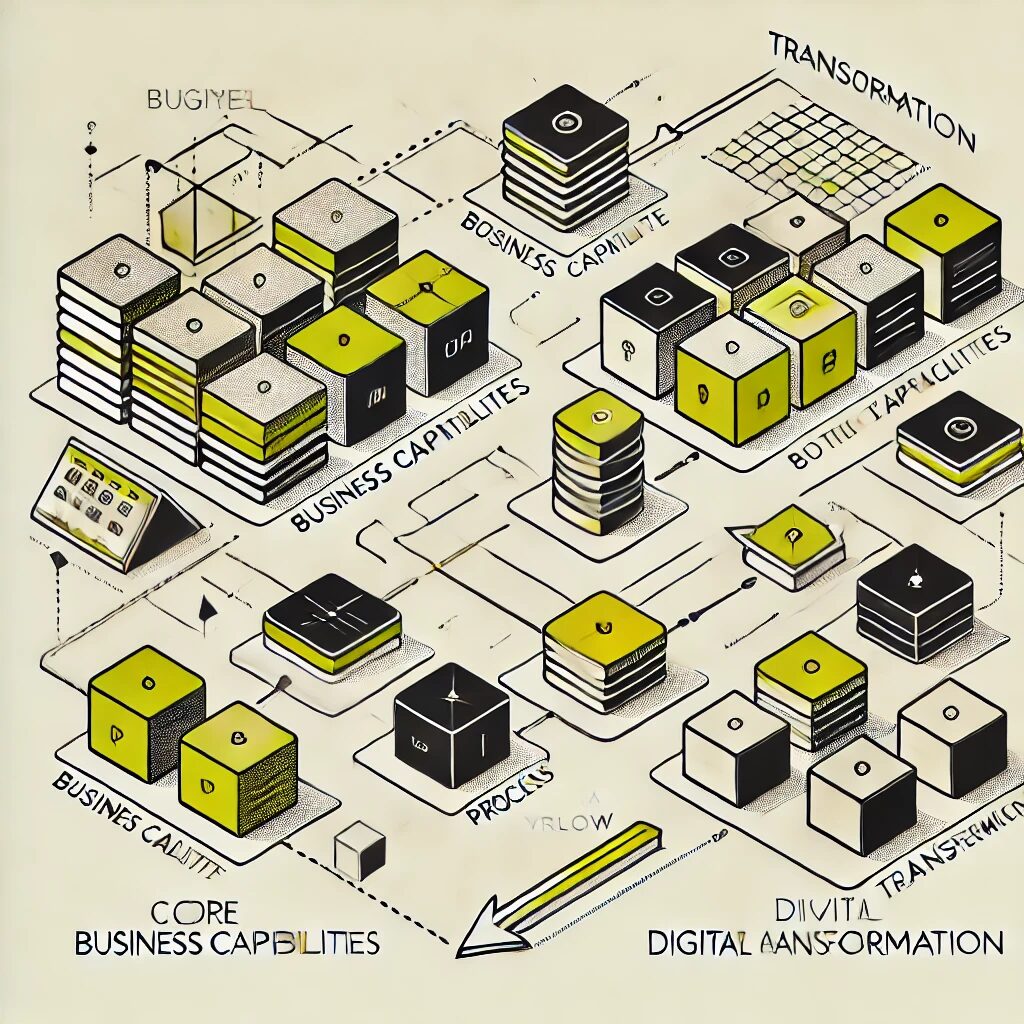
Transforming Real Estate Through Business Architecture. Blueprint for a digital-first real estate future.
In today’s rapidly evolving real estate landscape, firms face unprecedented challenges: market volatility, digital disruption, changing consumer expectations, and sustainability demands. Traditional approaches no longer suffice in an industry ripe for transformation.
Business Architecture offers real estate organizations a structured framework to navigate complexity and drive enterprise-wide transformation. By connecting strategy to execution and aligning business capabilities with technology investments, it creates the foundation for sustainable growth and competitive advantage in an increasingly digital marketplace.
1: The Real Estate Transformation Imperative
The real estate industry stands at a critical inflection point, with digital technologies, changing customer behaviors, and evolving market dynamics creating both opportunities and threats. Forward-thinking firms recognize the need for holistic transformation to remain competitive.
- Market Pressure: Intensifying competition and margin pressure are forcing real estate firms to rethink their traditional business models and value propositions.
- Digital Expectations: Today’s customers expect seamless digital experiences across the entire real estate journey, from search to transaction to property management.
- Operational Efficiency: Rising costs and administrative complexity demand streamlined processes and intelligent automation to maintain profitability.
- Data Opportunity: Vast amounts of untapped property and customer data represent significant potential for those who can effectively capture, analyze, and monetize these assets.
- Ecosystem Expansion: The boundaries between traditional real estate and adjacent services (financial, insurance, maintenance) are blurring, creating opportunities for new revenue streams.
2: Business Architecture as the Transformation Foundation
Business Architecture provides the essential framework that connects strategic vision to operational execution, ensuring transformation initiatives deliver tangible business outcomes. It creates a common language and comprehensive view of the organization.
- Strategy Translation: Business Architecture converts high-level corporate strategies into actionable building blocks that can be systematically implemented across the enterprise.
- Capability Mapping: Identifying and documenting core, competitive, and transformative capabilities creates clarity on what the organization does and where it needs to invest.
- Business-Technology Alignment: By creating clear relationships between business needs and IT systems, Architecture ensures technology investments directly support business objectives.
- Change Roadmapping: Sequencing initiatives based on business value, dependency management, and resource constraints ensures transformation occurs in manageable, value-generating increments.
- Decision Support: Architecture models provide the context and relationships needed for informed decision-making on investments, priorities, and trade-offs.
3: Mapping the Real Estate Value Chain
A comprehensive mapping of the real estate value chain reveals opportunities for optimization, innovation, and competitive differentiation. Business Architecture decomposes complex operations into understandable components.
- Property Acquisition: Systematically documenting processes for identifying, evaluating, and acquiring properties highlights opportunities for data-driven decision support and automation.
- Development Excellence: Architectural models of development workflows identify bottlenecks, redundancies, and compliance gaps that can be addressed through standardization and digital tools.
- Marketing and Sales: Capability mapping clarifies how digital channels, CRM systems, and personalization technologies can enhance prospect engagement and conversion rates.
- Property Management: Process decomposition reveals opportunities for IoT integration, predictive maintenance, and tenant experience platforms to improve operational efficiency.
- Investment Management: Architecture links financial processes, reporting requirements, and decision frameworks to enable more sophisticated portfolio optimization.
4: Capability-Based Planning for Real Estate
Capability mapping forms the cornerstone of Business Architecture, creating a stable foundation for transformation planning independent of organizational structure, processes, or technologies.
- Core Capabilities: Identifying foundational real estate capabilities such as property valuation, transaction management, and tenant relationships focuses attention on operational excellence.
- Competitive Capabilities: Architectural analysis reveals differentiating capabilities like market intelligence, customer experience, and sustainability management that drive competitive advantage.
- Transformative Capabilities: Mapping emerging capabilities in areas such as digital twin modeling, predictive analytics, and ecosystem orchestration guides innovation investments.
- Capability Assessment: Heat-mapping current capability maturity against future requirements highlights critical gaps requiring investment and organizational attention.
- Investment Alignment: Capability-based planning ensures technology and process investments directly enhance business outcomes rather than being technology-driven initiatives.
Did You Know?
- According to McKinsey, real estate companies that lead in digital transformation achieve 5-10% higher valuations than industry averages and 3-6% higher NOI from operational efficiencies.
5: The Real Estate Customer Experience Architecture
Business Architecture provides a structured approach to redesigning customer experience, ensuring consistency across touchpoints while addressing unique segment needs in the real estate journey.
- Journey Mapping: Comprehensive documentation of customer journeys from awareness through transaction to ongoing relationship reveals pain points and improvement opportunities.
- Segment Architecture: Architectural models capture distinct needs and behaviors of different customer segments (investors, tenants, buyers, sellers) to enable targeted experience design.
- Channel Optimization: Capability mapping across physical, digital, and partner channels ensures seamless omnichannel experiences that meet customers where they are.
- Digital Touchpoints: Architecture links customer-facing technologies to backend systems and data sources, creating the foundation for personalized, contextual interactions.
- Experience Measurement: Defining experience metrics and connecting them to operational KPIs enables continuous improvement of the customer journey.
6: Data as a Strategic Asset
Business Architecture provides the framework for treating real estate data as a strategic asset, connecting information needs to business objectives and enabling advanced analytics capabilities.
- Data Domain Mapping: Architectural classification of property, customer, market, and operational data domains creates clarity on information ownership and governance requirements.
- Information Flow Analysis: Mapping how data moves through the organization reveals bottlenecks, redundancies, and opportunities for integration and process optimization.
- Analytics Capability Building: Architecture links business questions to data sources, analytical techniques, and visualization approaches needed for insight generation.
- Data Governance Structure: Architecture establishes the foundation for data quality, security, privacy, and compliance through clear policies, standards, and accountabilities.
- Monetization Opportunities: Architectural analysis uncovers potential for data products, partnership opportunities, and insights services that create new revenue streams.
7: Technology Portfolio Optimization
Business Architecture enables strategic management of the technology portfolio, ensuring investments directly support business capabilities and create a coherent, future-proof technology landscape.
- Application Rationalization: Mapping business capabilities to supporting applications identifies redundancies, gaps, and legacy systems that can be consolidated or retired.
- Investment Prioritization: Architectural analysis guides technology investment decisions based on business impact, capability gaps, and strategic alignment rather than technical factors alone.
- Integration Strategy: Business Architecture informs API and integration approaches that connect systems while maintaining flexibility for future changes.
- Technology Roadmapping: Architecture creates the foundation for multi-year technology planning that balances immediate needs with long-term strategic objectives.
- Build vs. Buy Decisions: Architectural context enables more informed make-vs-buy analysis based on capability criticality, competitive differentiation, and integration considerations.
8: Digital Platform Architecture for Real Estate
Business Architecture guides the transition from siloed legacy systems to a modern digital platform approach that enables flexibility, innovation, and ecosystem participation.
- Platform Capability Definition: Architectural decomposition identifies core platform capabilities needed to support both internal operations and external ecosystem partners.
- API Strategy: Business Architecture informs the development of APIs that expose valuable business capabilities to internal and external consumers in a controlled manner.
- Experience Layer Design: Architecture ensures consistent user experiences across different touchpoints while connecting to backend capabilities and data.
- Integration Framework: Establishing architectural patterns for system integration creates consistent approaches that reduce complexity and technical debt.
- Technology Selection Guidance: Business Architecture provides the context for platform technology selection based on capability requirements, scalability needs, and strategic fit.
9: PropTech Ecosystem Integration
Business Architecture enables strategic management of the PropTech ecosystem, ensuring external innovations integrate effectively with internal capabilities to create maximum business value.
- Ecosystem Mapping: Architectural analysis of the PropTech landscape identifies potential partners, integration points, and capability gaps that could be filled through partnerships.
- Integration Architecture: Defining standardized approaches for PropTech integration reduces implementation costs, security risks, and operational complexity.
- Capability Augmentation: Architecture highlights where internal capabilities can be enhanced through external partnerships rather than custom development.
- Vendor Risk Management: Architectural models provide the foundation for assessing technology and operational dependencies on ecosystem partners.
- Innovation Funnel: Business Architecture guides the evaluation of emerging PropTech solutions based on strategic fit, capability enhancement, and integration complexity.
10: Governance for Sustainable Transformation
Business Architecture establishes the governance framework necessary to sustain transformation over time, ensuring decisions remain aligned with strategic objectives and architectural principles.
- Decision Rights: Clearly defined decision authorities and escalation paths for architectural decisions prevent inconsistent approaches and misaligned investments.
- Architecture Review Processes: Establishing structured reviews of projects and initiatives ensures alignment with architectural standards and enterprise direction.
- Capability Ownership: Assigning clear ownership of business capabilities creates accountability for performance improvement and transformation outcomes.
- Standards Management: Architectural governance defines, documents, and enforces standards that reduce unnecessary variation and technical debt.
- Benefit Realization: Governance processes track the delivery of promised business benefits from transformation initiatives, providing feedback for continuous improvement.
Did You Know?
- A Deloitte study found that 70% of real estate firms with mature Business Architecture capabilities complete major transformation initiatives on time and on budget, compared to just 30% of those without such capabilities.
11: Business Architecture for Sustainable Real Estate
Business Architecture plays a crucial role in embedding sustainability into the operational fabric of real estate organizations, connecting environmental goals to concrete capabilities and processes.
- Sustainability Capability Mapping: Architectural analysis identifies capabilities needed for carbon management, energy optimization, waste reduction, and sustainability reporting.
- ESG Integration: Business Architecture connects environmental, social, and governance considerations to core business processes and decision frameworks.
- Green Building Standards: Architecture establishes connections between sustainability standards and development processes, ensuring consistent application across properties.
- Measurement Framework: Defining sustainability metrics and their relationships to operational KPIs creates accountability and transparency for environmental performance.
- Circular Economy Opportunities: Capability mapping reveals opportunities for material reuse, waste reduction, and lifecycle extension that create both environmental and economic benefits.
12: Change Management and Organizational Impact
Business Architecture provides the foundation for effective change management by clarifying impacts, dependencies, and transition states during transformation.
- Impact Analysis: Architectural models enable systematic assessment of how changes to processes, systems, and data affect different parts of the organization.
- Role Evolution Mapping: Architecture highlights how roles and responsibilities need to evolve as capabilities mature and new technologies are introduced.
- Skill Gap Identification: Comparing current organizational capabilities to future requirements reveals training needs and potential talent acquisition requirements.
- Change Sequencing: Architecture provides the foundation for planning change in digestible increments that build momentum while managing organizational capacity.
- Cultural Alignment: Business Architecture connects transformation initiatives to core values and cultural attributes that need reinforcement or evolution.
13: Measuring Transformation Success
Business Architecture establishes the measurement framework that connects transformation initiatives to tangible business outcomes, ensuring accountability and value realization.
- Outcome Mapping: Architectural models link strategic objectives to specific measurable outcomes that demonstrate transformation progress and value.
- Capability Metrics: Defining performance indicators for each business capability creates a foundation for tracking maturity improvement over time.
- Value Realization Tracking: Architecture connects initiatives to expected business benefits, enabling systematic measurement of actual versus projected value.
- Leading Indicators: Identifying early signals of transformation success or challenges enables proactive course correction before issues impact outcomes.
- Continuous Feedback Loops: Architectural governance establishes mechanisms for incorporating measurement insights into future transformation planning.
14: The Business Architect’s Role in Real Estate Transformation
Business Architects play a multifaceted role in guiding real estate organizations through complex transformation journeys, combining strategic thinking with practical implementation knowledge.
- Strategic Partner: Business Architects work alongside executives to translate vision into actionable transformation roadmaps that deliver measurable business value.
- Complexity Navigator: Architects create clarity from complexity by developing models that make relationships, dependencies, and impacts visible and understandable.
- Cross-Functional Facilitator: Business Architects bridge organizational silos, creating shared understanding and alignment across business functions, IT, and external partners.
- Future State Visualizer: Developing compelling representations of the future state helps stakeholders understand transformation goals and their role in achieving them.
- Pragmatic Implementer: Beyond theoretical models, effective Business Architects provide practical guidance that balances architectural purity with implementation realities.
15: Starting Your Business Architecture Journey
Establishing Business Architecture capability requires a thoughtful approach that balances immediate value delivery with long-term capability building. Several key steps can help real estate firms begin their architectural journey.
- Quick-Win Identification: Begin with focused architectural work that addresses immediate business challenges while demonstrating the value of the architectural approach.
- Executive Sponsorship: Securing leadership commitment by connecting Architecture to strategic objectives and tangible business outcomes ensures necessary organizational support.
- Capability Foundation: Developing a high-level capability map creates a common language for transformation and a foundation for more detailed architectural work.
- Talent Development: Building architectural thinking requires both dedicated architects and broader organizational understanding of architectural principles and practices.
- Tool Selection: Choosing appropriate tools for capturing, managing, and communicating architectural artifacts balances usability with analytical power.
- Governance Integration: Embedding architectural review into existing governance processes ensures consistent application of standards without creating unnecessary bureaucracy.
Did You Know?
- Real estate organizations with formalized capability-based planning are 2.5x more likely to successfully integrate acquisitions and new business models than those using traditional planning approaches.
Takeaway
Business Architecture provides real estate organizations with the structural foundation needed to navigate complex transformation journeys successfully. By connecting strategy to execution, aligning capabilities with investments, and providing a common language across the enterprise, Architecture dramatically increases the probability of transformation success. In an industry experiencing unprecedented disruption, architectural thinking creates the clarity, alignment, and adaptability needed to respond to change and proactively shape the future of real estate.
Next Steps
- Conduct a capability assessment to identify critical gaps and opportunities in your organization’s real estate operations.
- Develop a high-level Business Architecture blueprint that connects your strategic objectives to specific capabilities, processes, and systems.
- Identify one high-value transformation initiative where architectural thinking can demonstrate immediate business impact.
- Establish a cross-functional Architecture steering committee to ensure alignment between business strategy and transformation initiatives.
- Invest in Architecture skills development through training, mentoring, or strategic hiring to build sustainable in-house capability.


